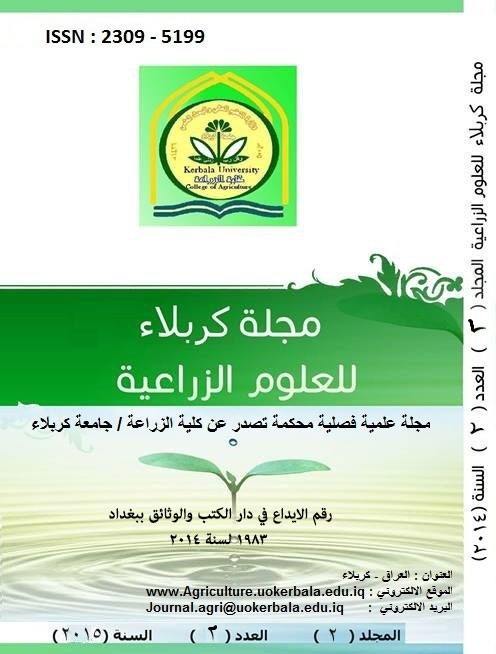Effect of adding locally probiotic and Cupric Sulphate to Laying Hens Diets on the Performance , Egg Yolk Cholesterol and Blood biochemical Parameters
DOI:
https://doi.org/10.59658/jkas.v2i4.69Abstract
The present experiment aimed to study the effect of diets supplementation with local probiotic (IRAQI PROBIOTIC ™), and cupric sulphate (CuSo4) on performance of shaver laying hens. A locally prepared probiotic were used each one gram of this probiotic contain Lactobacilli , Lactobacillus acidophilus, Bacillus subtilus and Saccharomyces cerevisiae yeast. A total of 112, 42 week old, Shaver laying hens were divided into 7 treatments with 4 replicates per treatment (4 laying hens per replicate). Laying hens in T1 were fed a basal diet used as control. Laying hens in T2, T3 and T4 were fed diets supplemented with 5 ,10 and 15gm/kg ration of local probiotic respectively, Laying hens in T5,T6 and T7 were fed diets supplemented with 100,200 and 300ppm of cupric sulphate respectively. The experiment was conducted at the poultry farm belong to Animal Resources, College of Agriculture, University of AL- Anbar . During the experimental periods hens performance traits included egg production, egg weights, egg mass, feed consumption, and feed conversion ratio were recorded, At the end of the experimental periods blood serum and egg yolk samples were collected for cholesterol analysis and biochemical which including glucose, protein, albumin, globulin, triglycerides, high density lipoprotein (HDL), low density lipoprotein (LDL), very low density lipoprotein (VLDL), Liver weights, GOT and GPT enzymes. A significant increase (p<0.05) of record the laying hens supplemented with local probiotic T2 (adding local probiotic 5 gm/kg) , T3 (adding local probiotic 10 gm/kg) ,T4 (adding local probiotic 15 gm/kg) in egg production and egg mass as compare with other treatments. In general the study revealed that there were a significant improvement (P<0.05) in feed conversion ratio of T2(adding local probiotic 5 gm/kg) ,T3 (adding local probiotic 10 gm/kg) ,T4 (adding local probiotic 15gm/kg) ration compared with T1(control). Serum cholesterol concentration, triglycerides, low density lipoprotein (LDL) and very low density lipoprotein (VLDL) were decreased markedly by both local probiotic and cupric sulphate supplementation, while high density lipoprotein (HDL) increased in both local probiotic and cupric sulphate treatments. There were no differences (p>0.05) regarding in feed intake, total glucose ,total protein, total albumin, total globulin ,liver weight, GOT and GPT enzymes
Downloads
Published
How to Cite
Issue
Section
License
Copyright (c) 2015 Copyright (c) 2024 is the Author's article. Published by the Journal of Kerbala for Agricultural Sciences under a CC BY 4.0 license

This work is licensed under a Creative Commons Attribution 4.0 International License.
Licensing Terms
All articles are published under a Creative Commons License and will be directed to the Creative Commons Attribution 4.0 International License (CC BY 4.0) That permits use, distribution, and reproduction in any medium, provided the original work is properly cited. This license also allows the work to be used for commercial purposes.
Use by both non-commercial and commercial users
This content is licensed under a Creative Commons Attribution 4.0 International (CC BY 4.0) license, permitting use by both non-commercial and commercial users. Individual users may access, download, copy, display, and redistribute the articles to colleagues, as well as adapt, translate, and text- and data-mine the content, subject to the following conditions:
- The author's moral rights, including the right of attribution and the right to protect their work from derogatory treatment, are respected.
- Where content in the article is identified as belonging to a third party, users must ensure that any reuse complies with the copyright policies of the owner of that content.
- If the article content is reused for research or educational purposes, users should maintain a link to the appropriate bibliographic citation, including the DOI and a link to the published version on the journal's website.

